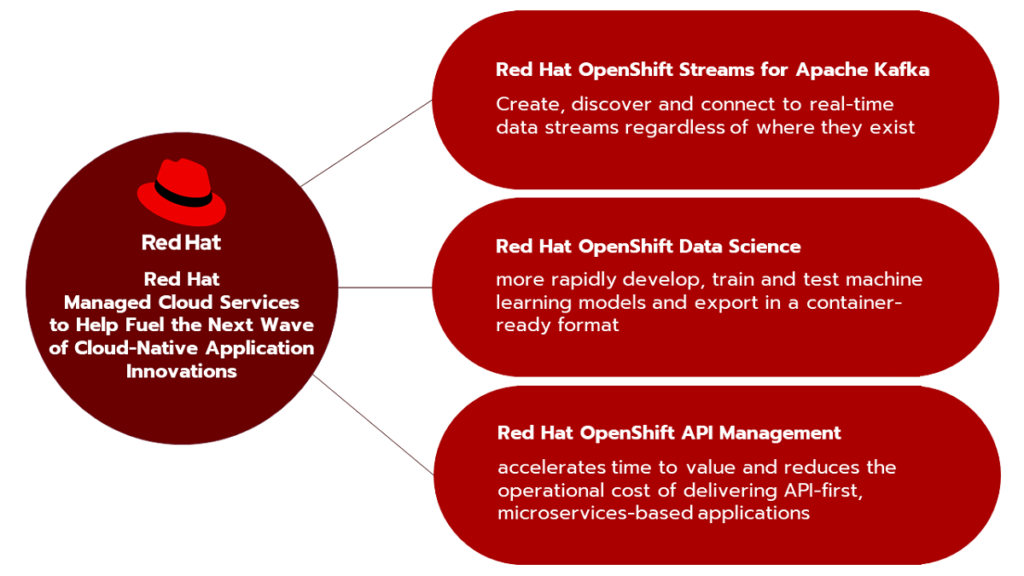New set of fully hosted and managed cloud services enhances customer choice for open hybrid cloud computing, helping to reduce complexity and maximize IT investments
Red Hat, Inc., the world’s leading provider of open source solutions, today announced the expansion of its open hybrid cloud technology portfolio with new managed cloud services. Red Hat OpenShift API Management, Red Hat OpenShift Streams for Apache Kafka and Red Hat OpenShift Data Science are designed to deliver a fully-managed and streamlined user experience as organizations build, deploy, manage and scale cloud-native applications across hybrid environments. These services are tightly integrated with Red Hat OpenShift Dedicated and help mitigate the operational complexities of highly-complex modern IT environments without sacrificing developer productivity, providing a common set of capabilities across the full breadth of the open hybrid cloud and on multiple clouds.
2020 emphasized just how critical hybrid cloud operations at-scale are for CIOs and IT leaders, especially when faced with expanding service demand while maintaining existing infrastructure commitments. To address this new reality, customers and partners want flexibility in how they adopt technologies to deliver any application, anywhere, without additional overhead or complexity. These foundational cloud services shift operational responsibility and support to Red Hat and enable customers to build next-generation applications with a focus on distributing data and enabling API-driven access to it. The new services include:
Red Hat OpenShift Streams for Apache KafkaBased on the open source Apache Kafka project, Red Hat OpenShift Streams for Apache Kafka enables development teams to more easily incorporate streaming data into their applications. When designing hybrid cloud applications, data streams provide the backbone for capturing, communicating and processing events for modern, distributed application architectures. Real-time data is a critical component of functional hybrid cloud applications, providing more immediate digital experiences to wherever a service is delivered. As a fully-managed and hosted Kafka service, Red Hat OpenShift Streams for Apache Kafka enables developers to focus on building better applications more quickly, without having to worry about the underlying requirements of data collection and processing.
Red Hat OpenShift Streams for Apache Kafka is available as a developer preview, with general availability expected later this year. Learn more about Red Hat OpenShift Streams for Apache Kafka.
Red Hat OpenShift Data ScienceRed Hat OpenShift Data Science builds on the open source Open Data Hub project and provides for the faster development, training and testing of machine learning models without the associated infrastructure demands. Red Hat OpenShift Data Science implements common data science tools as the foundation of an AI-as-a-Service platform integrated with select partner cloud services, including ISV solutions from Red Hat Marketplace.
Red Hat OpenShift Data Science is available in beta as an add-on to OpenShift Dedicated and Red Hat OpenShift Service on AWS, with general availability expected later this year. Learn more about Red Hat OpenShift Data Science.
Red Hat OpenShift API ManagementRed Hat OpenShift API Management offers full application programming interface (API) lifecycle management to Red Hat OpenShift Dedicated and Red Hat OpenShift Service on AWS. Combining managed operations with native OpenShift integration enables organizations to focus on innovation and development in building, managing and scaling API-first, microservices-based applications instead of infrastructure. Red Hat OpenShift API Management also enables customers to build their own API management program, with the capabilities to control access, monitor usage, share common APIs and evolve their overall application landscape through a single DevOps pipeline.
Red Hat OpenShift API Management is fully available today as an add-on to Red Hat OpenShift Dedicated, and on Red Hat OpenShift Service on AWS. Learn more about Red Hat OpenShift API Management.
Red Hat OpenShift: Flexible, managed innovation across the open hybrid cloudThese new managed cloud services build on Red Hat’s existing portfolio of Red Hat OpenShift offerings, which provide self- and fully-managed Kubernetes across leading public clouds. This enables Red Hat customers and partners to build an open hybrid cloud strategy based on the industry’s leading enterprise Kubernetes platform, regardless of on-premises infrastructure assets or operational staffing.
Today’s announcement also opens the door for Red Hat partners, independent software vendors (ISVs) and systems integrators (SIs) to offer new, value-added services to their clients. Customers can use these services in conjunction with technology partner offerings, including solutions available via Red Hat Marketplace, that are tested, certified and supported on Red Hat OpenShift.
Supporting Quotes
Matt Hicks, executive vice president, Products and Technologies, Red Hat”To take full advantage of the open hybrid cloud, IT leaders need to be able to use the technologies that they need in whatever IT footprint makes sense for them. Red Hat managed cloud services effectively drops many barriers that have kept organizations from harnessing the full potential of the hybrid cloud. We believe eliminating the traditional overhead of managing cloud-scale infrastructure will spark a genesis moment for customers and open up a future of possibility where those barriers once stood.”
Stephen O’Grady, principal analyst, RedMonk”As enterprises look to improve their application development velocity, many are looking to decrease the operational burden of their development teams by leveraging managed cloud services. This allows the focus to be on delivering business value, rather than spending valuable resources on infrastructure management. With Red Hat OpenShift and a curated, tightly-integrated set of services that runs across multiple clouds, Red Hat intends to allow its customers to do just that.”
Source: FAQ
